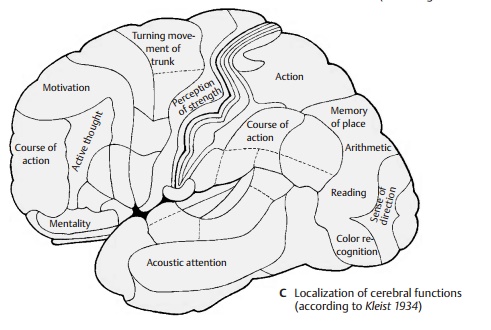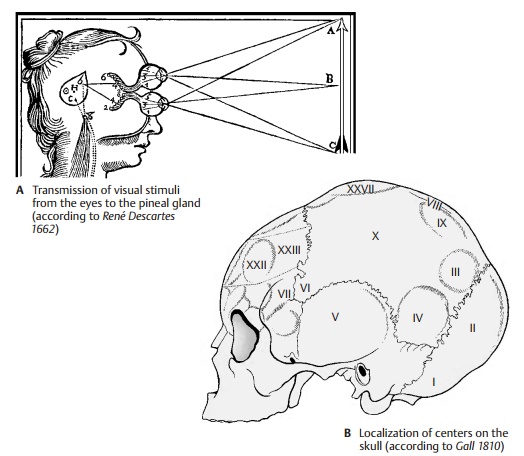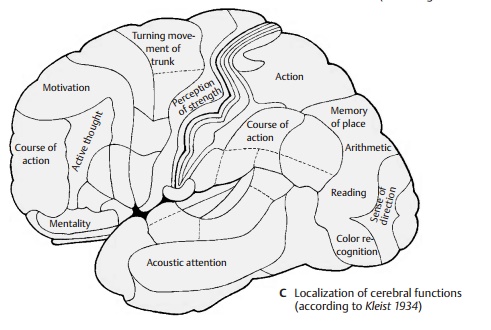Chapter: Human Nervous System and Sensory Organs : Functional Systems
Brain Function

Brain Function
The
central nervous system enables the organism to adapt to the environment and to
survive. It receives stimuli from outside and inside the body through the
sensory organs; it then filters the stimuli and processes them into
information. In accordance with this information, it sends impulses to the
periphery of the body so that the organism can react in a meaningful way to the
con-stantly changing conditions. The functional systems described in this
chapter are by no means independent, isolated sys-tems. The highly simplified
and schematic description is supposed to provide an ap-proximate illustration
of the extremely complex interactions among billions of nerve cells.
For
centuries there has been the simple mechanistic idea that sensations reach the
brain and the brain then triggers motor re-actions. According to Descartes, optic stimuli are
transmitted from the eyes to the pineal gland (epiphysis), which then sends
im-pulses that travel to the muscles (A).
He viewed the pineal gland as the seat of the soul. Franz Gall was the first to postulate the importance of the
cerebral convolutions and the cerebral cortex for brain function. He localized
the “organs of the soul” on the surface of the hemispheres, and he believed
that mental faculties could be determined to various degrees by the
topographical fea-tures on the surface of the skull (phrenology) (B). He used
Roman numerals for localizing these features: I, reproductive instinct; II,
love of offspring; III, friendship; IV, bravery; V, instinct to eat meat; VI,
intelligence; VII, greed and cleptomania; VIII, pride and arrogance; IX,
vanity and ambition; and so on.

On the
basis of brain injuries, Kleist
arrived at localizations of higher cerebral functions (C). He assumed that positive capacities, or “functions,” would
correspond to deficits in recognition and thinking, motivation and action,
among others, which were ex-pressed as negative pathological findings. However,
this is not so. While it is possibleto localize symptoms of deficit, this
cannot be done for capacities (von Monakow). Crit-ics of this theory of localization and centers spoke
of “brain mythology.” Ultimately, specific capacities cannot be attributed to
specific brain regions because immense numbers of other neuronal groups are
al-ways participating in the stimulation, inhi-bition, or modulation of a
capacity. The so-called “centers” can be regarded, at best, as important relay stations for a particular
capacity. Nor is the central nervous system a rigid apparatus; rather it
exhibits a con-siderable degree of plasticity.
Especially in the infant brain, other centers can take over and perform
functions in place of injured parts of the brain. Plasticity of our principal
organ is also a prerequisite for the capacity to learn (language, writing,
physical skills).

Information
processing in the telencephalon is known as integration. It refers to the combination and interconnection of
sensations, including stored experience, to form a higher and complex
functional unit. In this way, the functions of the organism are guided by means
of the meticulous mutual coordination between groups of neurons. During human
evolution, the inte-grative processes of regulating and coordi-nating
elementary biological tasks have developed into conscious recognition, thought,
and action. Cybernetics and com-puter technology have provided us with models
for the function of the brain (cogni-tive science). According to these models,
various “functions” are based on the con-tinuously changing stimuli within
intercon-nected neuronal circuits.
Despite
our highly developed instrument technology, there is ultimately only one
in-strument available for brain research: the brain itself. In other words, a
human organ is involved in an attempt to investigate its own structure and
function.
Related Topics